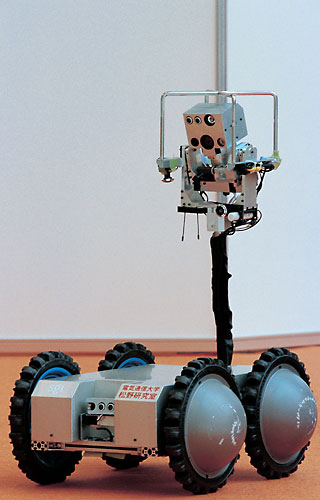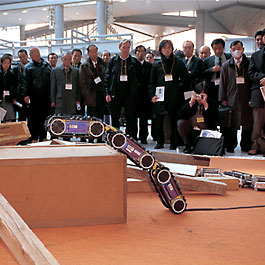|
Special Feature*
 |

Left: This rescue robot, called Fuma, has heat and distance sensors and a camera to search for information useful to rescuers. It can move over obstacles.
Above: Another robot, named Soryu, is at the most developed stage, so it is closest to being used in a future disaster. It crawls over obstacles in collapsed buildings and other places, looking for survivors with a camera and heat sensors at its tip.
|
Searching for signs of life after a disaster
Rescue robots
" When the Kobe region was hit by an earthquake in 1995, I was in nearby Osaka. I'd never been more scared in my life. One thing that struck me, strange as it is, was that no rescue squad appeared on fantastical machines like in the science fiction TV puppet series Thunderbirds.( see Note) I was researching robots even back then, but I hadn't thought of robots and other automatic devices as things that could possibly save lives after a disaster, " says Osuka Koichi, a professor at Kobe University. Quite a few robot researchers had not recognized this potential. Some of them got together during that same year, 1995, to form a society promoting research in rescue robots. By 2002, the society had grown into the International Rescue System Institute (IRS), a nonprofit organization that conducts research into robots and other automatic machines for disaster-relief systems. The robots pictured on this page were developed as a result of IRS research.
Osuka explains, " We studied rescue efforts after the 1995 earthquake and realized that ordinary robots have no rescue value. They can't move about unless the area is clean and free of obstacles. To be useful after a disaster, machines have to withstand small explosions, fire, dust and water. They must be able to either look for people from above the ground or crawl into small spaces to find them. They have to be designed for a specific disaster-related purpose, and they have to do the job properly. Rescue robot development now follows those guidelines."
IRS is also developing unmanned helicopters and blimps to gather information from above a disaster site, and small home-based communication terminals for people to use to communicate if they are trapped at a disaster site. " After we finish developing the home-based terminals, we will develop mobile devices for rescue squads to communicate with trapped people."
Professor Osuka's robotic rescue team is hardly the same as the one in Thunderbirds, but it will soon be ready to achieve some of the same goals.
| Note: |
The science fiction puppet TV series Thunderbirds began broadcasts in Britain in 1965.
It featured International Rescue, an organization whose members sped around the world on fantastic vehicles saving people. |
|